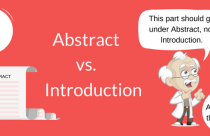Top Three Tips for Writing a Good Introduction

The introduction is one of the main sections of a research article. In this section, referees, editors, and readers can find out what the study is about, what motivated the author to carry out the study, and why the topic of the research is important. The introduction also provides relevant background information and puts the study into context, guiding the readers through the rest of the manuscript and helping the authors describe the depth and challenges of the study.
Writing a good introduction can be a tricky task, authors usually prefer to write this part of the manuscript at the end of the drafting process —once they know what the article will contain and how it will be structured— to ensure that they do not miss anything. These three tips could help authors write a strong introduction:
Tip 1: Set the Context and Explain the Need for Your Work
To start with, authors should provide general information about their study. Authors should state why the work is important and which advances it provides with respect to current knowledge. The goal is to create a compelling and clear article that will win the interest of referees, editors, and readers.
To support the claims and to put the study into context, the introduction should include a summary of relevant, up-to-date publications in the field. This (very short) literature review should be written in a way that appeals to a broad audience and clearly explains the need for the study. It is advisable to not include unnecessary information and provide only what will help readers better understand the importance of the paper.
Using phrases such as “recently”, “during the past 10 years”, or “since the discovery of…” can help anchor the context in time. Authors can also place their work within a given research field (e.g. “in the biomedical field,…” or “conducting polymers have received much attention because…”)
Authors must ensure to describe the problem as clearly as possible. Authors should start by discussing the current situation and then state what they would like to achieve, change, or study. Using words such as “but”, “however”, or “unfortunately” can help emphasize the contrast between the current and desired situations.
An effective way to express the objectives of the study is to combine the problem with what has been done to solve it and present it in a single sentence. There are many verbs that can be used to describe the study (investigate, study, measure, design, analyze, develop, model, etc.) and many ways to emphasize the authors’ contribution. For example:
“Material A has received much attention in recent years because of its optical properties. However, its low stability has limited its widespread use. To tackle this problem, we designed a …”
A good introduction should also prepare the readers for the structure of the paper and set up their expectations regarding its content. Here are a few examples:
“This article discusses the importance of…”
“This manuscript summarizes our results on…”
“This communication describes the mechanism by which…”
“This paper reports on…”
Tip 2: Use the Right Tone and Tense
When writing the introduction, authors should use a formal, impersonal tone. While stating accepted facts or truths —or describing a permanent situation— authors can use the present simple tense; for example:
“Gold is a noble metal…”
However, while describing a particular result or a temporary situation, it is preferable to use the past simple tense and provide the appropriate reference:
“In that study,[1] gold catalyzed the reaction…”
In some cases, it might be convenient to use the present perfect tense while addressing a problem that has not been solved or looked at before; for example:
“Although the properties of the material are well known, little attention has been paid to…”
or
“The exact mechanism has not been reported before…”
Tip 3: Be Organized
In general, one to four paragraphs should be enough for the introduction, but in order to explain concepts or recent developments in more detail, it might be a good idea to add an additional section —called “State of the Art”, “Background Information”, or something similar— where these terms and/or advances can be discussed better.
A good text must be arranged logically. Thus, the references included in the introduction should be presented in a way that the reader understands why the authors were interested in the study objective. This may be achieved by discussing the studies chronologically; by grouping approaches, theories, or models; or by going from general to specific descriptions.
To make the introduction more understandable, authors can divide it in four parts:
- Establish the importance of the topic.
- Discuss previous and/or current research in the field.
- Identify the problem and explain the approach taken to address it.
- Briefly describe the present paper.
How often have you got confused between the content of an abstract and an introduction of a research paper? Learn the difference between abstract and introduction to draft an effective research paper.
You can also visit our Q&A forum for frequently asked questions related to different aspects of research writing and publishing answered by our team that comprises subject-matter experts, eminent researchers, and publication experts.









